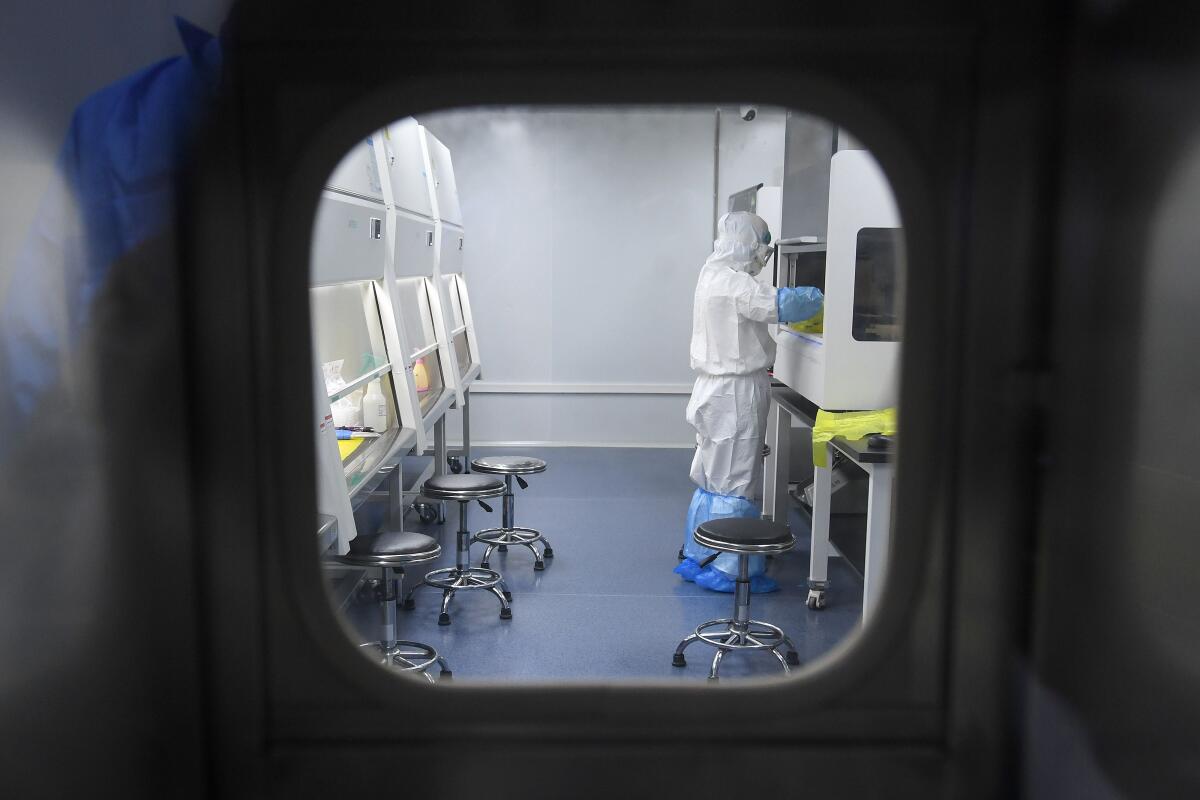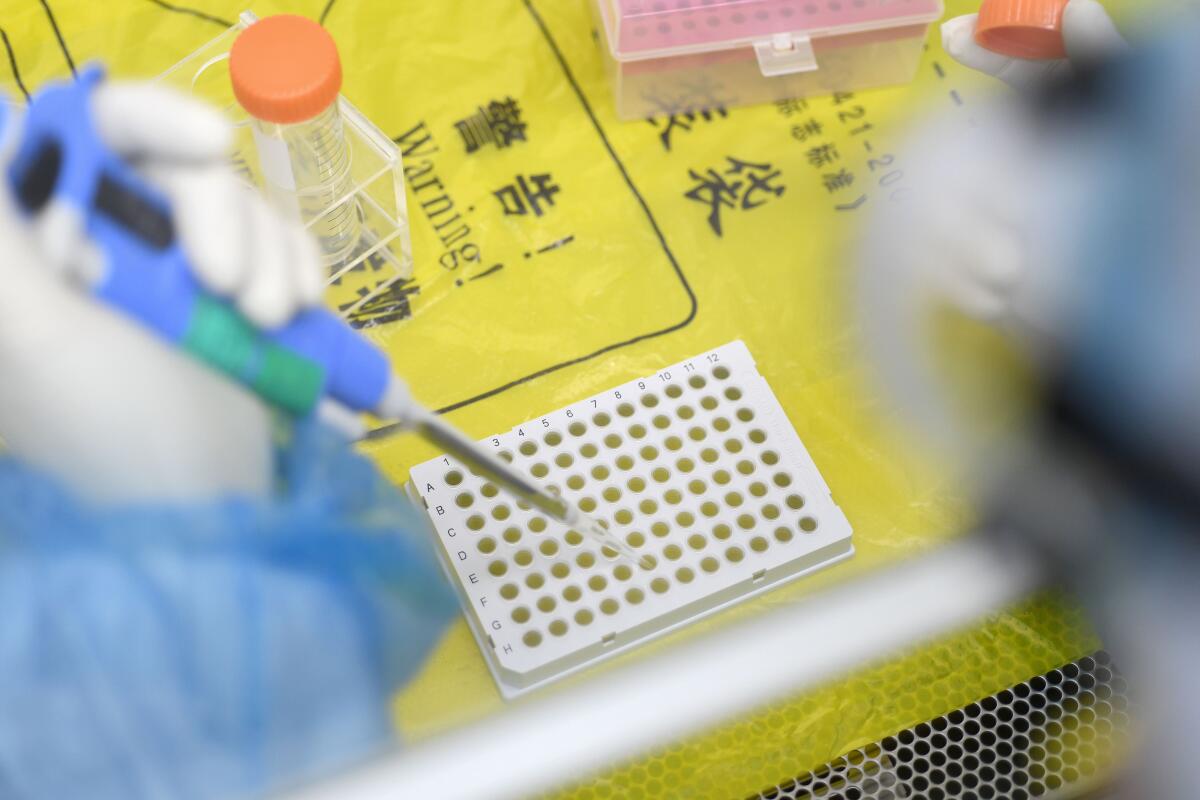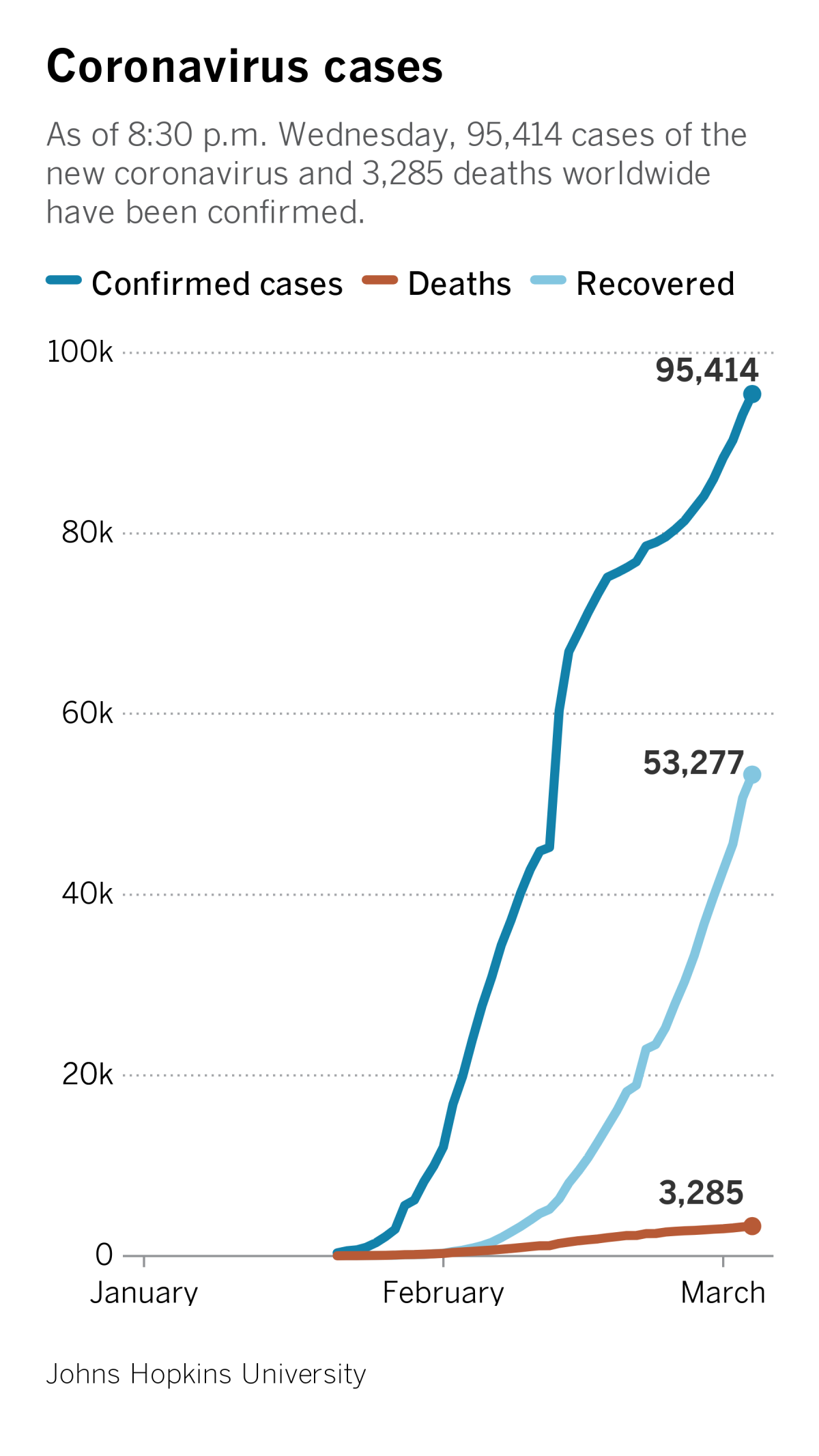By decoding the coronavirus genome, scientists seek the upper hand against COVID-19

- Share via
The genetic code of the coronavirus that causes COVID-19 is only about 30,000 characters long, but what a story it tells.
Those nucleotides conceal secrets of the virus’ past, including its origins, its passage among families and its journey to distant ports. They signal how long it has been at large and whether it can hide by infecting people who show no outward signs of illness. And they can point the way to medicines, vaccines and public health strategies that might bring a runaway crisis under control.
Unlocking all of that requires a combination of teamwork and technology that didn’t exist when the SARS epidemic broke out nearly 20 years ago. But today, when a deadly virus explodes out of nowhere, geneticists are indispensable players in the international game of whodunit.
“Now we can really get a much fuller version of that puzzle,” said Dr. Liliana Brown, who directs the office of genomics and advanced technology at the National Institute of Allergy and Infectious Diseases.
For much of the 20th century, the central technique of germ-hunting has been a labor-intensive process called contact tracing. It starts with a search for the person or people who were the first to be infected. Then the search expands to the people those initial patients interacted with, then the ones they interacted with, and so on.
With luck, the result is a time-stamped map of the germ’s spread that includes every case of illness, death and recovery. These investigations provide inferences and insights about how a pathogen spreads, how deadly it is, and what measures — including quarantines, school closures and travel restrictions — could slow its transmission.

Yet contact tracing is an imperfect process that relies on people’s memories, their candor, and an absence of chance encounters with strangers. With genomics, scientists can follow the progression of mutations from patient to patient and establish relatedness among them.
That can fill in gaps left by memory lapses or concealment. It can even flag new and worrisome means of transmissions between distant strangers — through vents or pipes linking apartments, for instance, or by airborne particles that linger longer than expected.
“Genomics has completely transformed our ability to track viruses and understand their spread,” said Kristian Andersen, a pioneer in this emerging field who is based at the Scripps Research Translational Institute in La Jolla. “We’re gaining insights not previously possible.”
::
A virus gives up its secrets one mutation at a time. As it passes from host to host, or population to population, it constantly sheds, gains or merely revises the sequences that define it.
Armed with powerful computers and a maturing grasp of how genes function and change, geneticists search through haystacks of data for the needles that will give them the upper hand.
To do so, they break down the DNA or RNA sequences of viral specimens collected from different people or animals. Then they stack those sequences on top of each other to see how and where they have changed. With enough samples, they can reconstruct a “tree” of viral descent.

By looking around the tree’s trunk — at the common ancestor of all samples — they may find an outbreak’s earliest patients. That can help scientists determine when the virus first colonized humans and narrow the list of animal species that might have incubated it.
They can peer further out in the branches to glean insights about who infected whom, how quickly transmission occurred, and whether mutations along the way made the virus more infectious or more lethal.
When the genetic diversity of samples seems improbably broad, researchers must explore new possibilities about the virus they are dealing with.
Perhaps it has infected far more people than initially thought, but spread without causing symptoms. Maybe it launched multiple assaults on humans from its home base in animals. Or it could have been circulating harmlessly in humans for years and recently acquired a mutation that causes its hosts to become ill.
It’s the biggest medical mystery on the planet: Just how deadly is the new coronavirus from China?
In just over a decade, this type of genetic sleuthing — scientists call it phylodynamic analysis — has changed the way disease detectives investigate an outbreak.
Genomic analyses of the Ebola virus turned up several points during its three-year reign of terror when it appeared to get better at jumping from person to person and demonstrated the value of closing the border between Sierra Leone and Liberia.
Studies of the Zika virus revealed that it became harmful to fetuses in 2013 while circulating in French Polynesia, more than a year before it triggered a wave of birth defects in Brazil.
Genetic sequencing helped identify bats as the origin of the virus responsible for Middle East respiratory syndrome, and camels as the animals that conveyed MERS to humans.
So far, Chinese scientists have sequenced the full genomes of at least 115 samples of the COVID-19 coronavirus and shared the details with an international community of geneticists, who are scouring them in a search for answers.

Already, these sequences have yielded evidence that the virus arose in a wildlife host before jumping to humans. Bats are the prime suspect because there is little to no difference between the RNA of viral samples taken from bats in and around Wuhan and of samples taken from people who were hospitalized with a pneumonia of unknown origin in the outbreak’s early days.
That same pattern — a tree with bats at the base of the trunk, the first human patients in Wuhan just a notch above them and more recent victims on increasingly broad branches — has allowed scientists to date the virus’ emergence in people to sometime around early December.

As an incidental benefit, the sequencing work has provided scientific corroboration of China’s claims about its management of the epidemic. Chinese authorities have asserted they responded quickly to the emergence of a dangerous new virus, and that they have held nothing back from the Chinese people or the international community. So far, the genetic data they’ve shared with the world suggest that’s true.
That hasn’t always been the case. In 2003, officials concealed the outbreak of severe acute respiratory syndrome, or SARS, in southern China, allowing the virus to spread to 16 other countries and kill 774 people.
::
Finally, combining genetic sequencing technology with old-fashioned disease hunting has given scientists a rare glimpse of evolution in near real time.
Observing it in long-lived organisms such as humans would take thousands of years. But viruses change constantly, and by sifting through samples from a single outbreak, researchers can capture the subtle process of adaptation with astonishing clarity.
Even a tiny shift might reveal a pivotal moment when the virus mutates in ways that either increase its fitness or spell its demise, said Dr. Marc Suchard, a biomathematician at UCLA who has studied the evolution of HIV and influenza.
Armed with the dynamic details of a virus’ life cycle, scientists can do more than confirm their surmises about how natural selection selects a winner, Suchard said. They can help answer some of the most fraught questions: Who should get vaccinated first? Will a quarantine work? When do comforting cultural practices endanger a community’s safety?
In a world of relentless viral threats, he said, the results could be life-saving.








